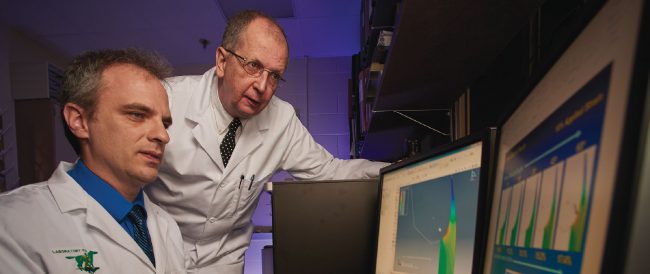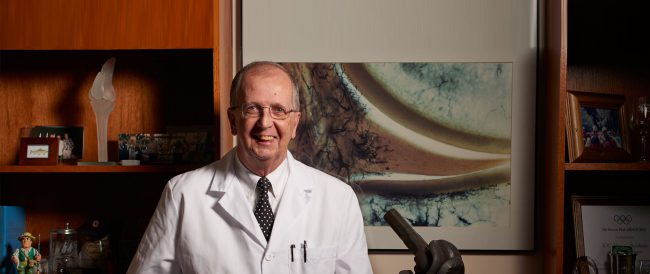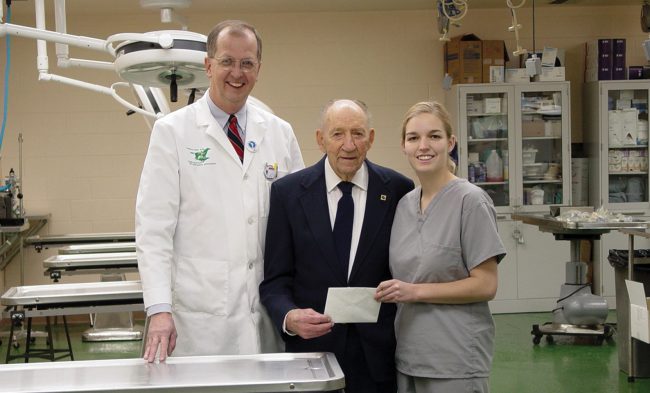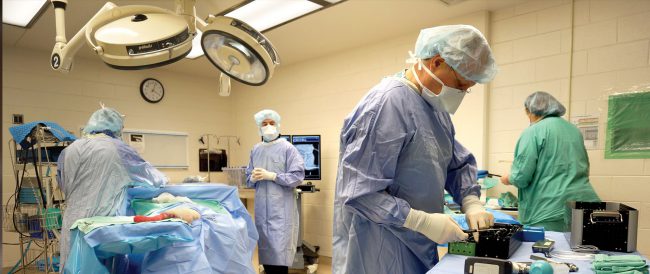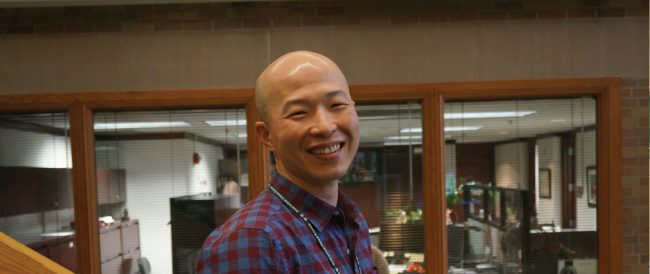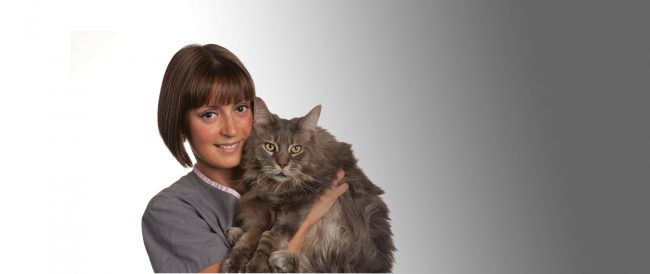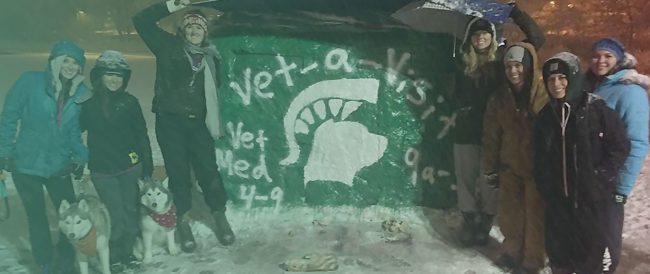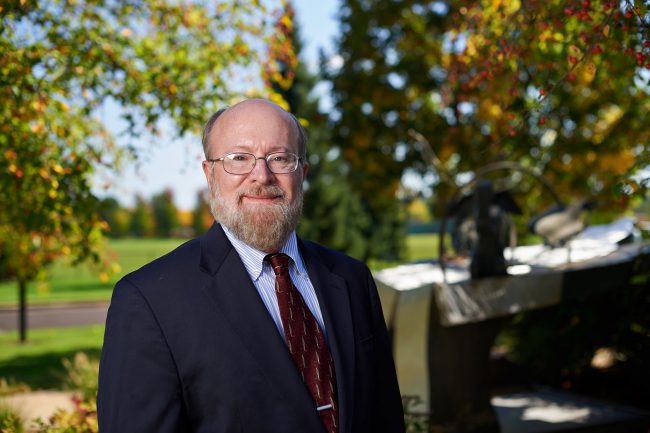 Read More
Read More
By Ann Kammerer

Advocacy of the veterinary medical profession, innovation in orthopedic surgery, and a training style that was both patient and demanding—these marked the career of Dr. Wade O. Brinker. Over the course of four decades at the MSU College of Veterinary Medicine, Brinker shaped the careers of DVM students. Many of those became orthopedic surgeons, but to all students, he taught the importance of surpassing ordinary standards. His commitment extended to the profession as a whole.
“He’s considered one of the founders of small animal orthopedics,” said Dr. Gretchen Flo, professor emeritus of veterinary medicine and a student, apprentice, colleague, and friend of Brinker’s. “In fact, he is probably THE founder. His presence is felt to this day.”
Building a Profession

Before 1950, the American Veterinary Medical Association recognized no formalized veterinary specialties. Specialty organizations and board- certified specialties emerged in the 1950s and 1960s, and Brinker influenced the organization of several specialty organizations.
Brinker was one of the five surgeons that began organizing the College of Veterinary Surgeons in the late 1950s and later helped shape the Veterinary Orthopedic Society (VOS). He is a founding father of AOVET, a global network of surgeons and scientists dedicated to improving surgical fracture treatment.
The wisdom and foresight Brinker provided as an early leader and founding member of AO, ACVS, and VOS laid the groundwork for specialty colleges, certification organizations, continuing education, and advancement of the orthopedic and veterinary professions.
The AO Foundation and AOVET
In the mid-1960s, bone plating became one of the most successful methods of internal fixation in human orthopedic surgery. This was due to the introduction of the Arbeitsgemeinschaft fur Osteosynthesefragen (AO) system of implants from Switzerland. The AO Foundation, or the Association of the Study of Internal Fixation, was formed and hosted the first course on the use of these instruments and implants in Davos, Switzerland, in 1960.
Before these developments, orthopedists usually treated fractures using splints with plaster bandages or the surgical techniques of intramedullary pinning and external fixation. Intramedullary pinning uses metal rods in the central cavity of the bone. In external fixation, holes are drilled into the bones around the fracture and bolts are screwed into the holes.
In 1969, Dr. Wade O. Brinker and four other veterinarians from North America attended a human AO course in Davos. These veterinarians became the first American veterinary orthopedists to work extensively with this equipment. AOVET was founded that year. Brinker become the second president of AOVET and the first North American president.
Dr. Gretchen Flo participated early on with AOVET, including teaching AO courses in Davos, Switzerland, and in the Netherlands. Dr. Terry Braden, too, was among the instructors at early AOVET courses. Today, Dr. Charles DeCamp is a regular instructor at AO meetings and delivers a talk on screw fixation of the sacroiliac joint several times a year.
Now, Dr. Loïc Déjardin holds leadership positions with the AO Foundation and AOVET, reinvigorating and strengthening MSU’s role in the organization.
Supporting a Surgical Residency
An Honored Legacy

Brinker’s awards and recognition include:
Veterinarian of the Year Award, Gaines Dog Research Foundation (1953)
Centennial Award for Distinguished Service, Kansas State University (1963)
Norden Teaching Award (1966)
Distinguished Faculty Award, Michigan State University (1969)
Wade O. Brinker Endowed Chair in Veterinary Surgery, Michigan State University (1978)
Distinguished Post-doctoral Alumnus, Michigan State University (1988)
Inaugural FounderS’ Award for Career Achievement, American College of Veterinary Surgeons (2005)
Shortly after he retired in 1978, thousands of students, colleagues, and friends of the College honored his many contributions to veterinary surgery by creating the Wade O. Brinker Endowed Chair of Veterinary Surgery at MSU. Today, that endowment continues Brinker’s commitment to scholarship in veterinary medicine.

“Brinker’s legacy consists of two things,” said Dr. Terry Braden, now professor emeritus of small animal clinical sciences, who was a student, colleague, and friend. “His research continues to have relevance today, and the clinical and teaching environment that he built still resonates at MSU.”
Brinker joined the faculty of MSU in 1939 and created a culture that has continued beyond his 40 years on staff.
From day one, Brinker applied his blend of people skills and scientific talents toward developing an internationally renowned small animal surgical program.“
What he left was a wonderful academic surgical culture that still exists to this day,” said Dr. Charles DeCamp. “To Brinker, teaching and clinical services were both very, very important. We still live with a lot of the work that he did early on.”
Brinker’s research led to new surgical approaches, orthopedic devices, treatment of fractures, and methods for storing and grafting bones. Many of Brinker’s surgical procedures for joint problems have stood the test of time and are mainstays in the arsenal for practitioners of small animal orthopedics.
“Research was very important to Dad,” Brinker’s son Jack said. “He started back when the vet clinic was a tiny place in Giltner Hall without a lot of staff. I remember him coming home to have dinner, calling his clients, and then working late at the dining room table.”
Those late nights were fruitful. Today’s practitioners can point to specific contributions that bear Brinker’s signature, including fundamental principles of intramedullary pinning in fracture repair, fracture fixation, and the concept and systems of rigid internal fixation—including bone plating.
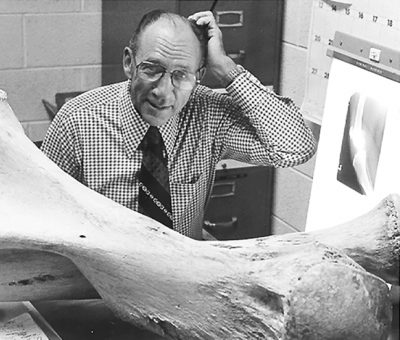
Braden also stressed the impact that Brinker had on shaping the direction of small animal orthopedics, as well as on Braden’s individual career. During Braden’s junior year working in treatment labs, he met Brinker, who was making the rounds.
“He asked me if I was interested in helping him and in scrubbing in for a surgery,” said Braden. “It was just serendipitous that we met.”
Braden became a close student of Brinker’s, and was prompted by his mentor to continue pursuing surgery, as well as orthopedics. In 1970, under Brinker’s leadership, the College’s surgery area started a residency program. Braden was encouraged to apply and became the very first resident in the MSU veterinary medicine arena.
“Brinker was so supportive,” Braden said. “He was a tremendous surgeon and was always willing to try something new. He encouraged me to do the same.”
Instilling the Culture

Open-mindedness, curiosity, and willingness to innovate underpins Brinker’s legacy across the College.
Wildlife specialist and associate professor Dr. James Sikarskie attended MSU in the early 1970s and joined the faculty just before Brinker retired. He recalls how his “favorite teacher” came into surgery labs to provide pointers. Sikarskie says Brinker fostered his interest in orthopedics and his later exploration of avian orthopedic surgery—both as a student and faculty member.
“Putting together broken bones is a lot like putting a puzzle back together,” Sikarskie said. “And while birds are different than mammals, he still had a great influence as a pioneer in fracture repair and impressions.”
Brinker set a tone, Sikarskie said, for thoughtfulness and respect—a tone that was reflected in small gestures, like bringing in homemade rock candy to share during the holidays, or through his gentle but precise approach to surgery.
“I remember colleagues using an orthopedic term to describe him,” Sikarskie laughed. “They would say he had round and smooth edges—while other orthopedic surgeons sometimes have sharp, bony edges. He was just so gentle, kind, and patient.”
That sentiment is confirmed time and again, particularly by those who worked closely with Brinker.
“One of his mottos was that he would like to see a resident do something better than he could do it,” Flo remembered. “He was a true teacher and lived by the Golden Rule. That’s something that transcends veterinary medicine into life.”


